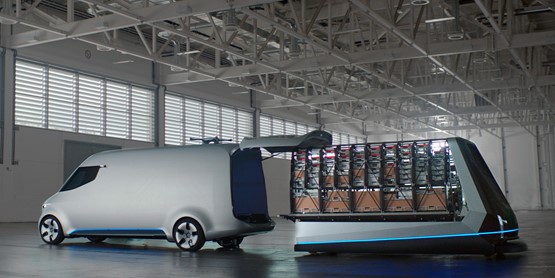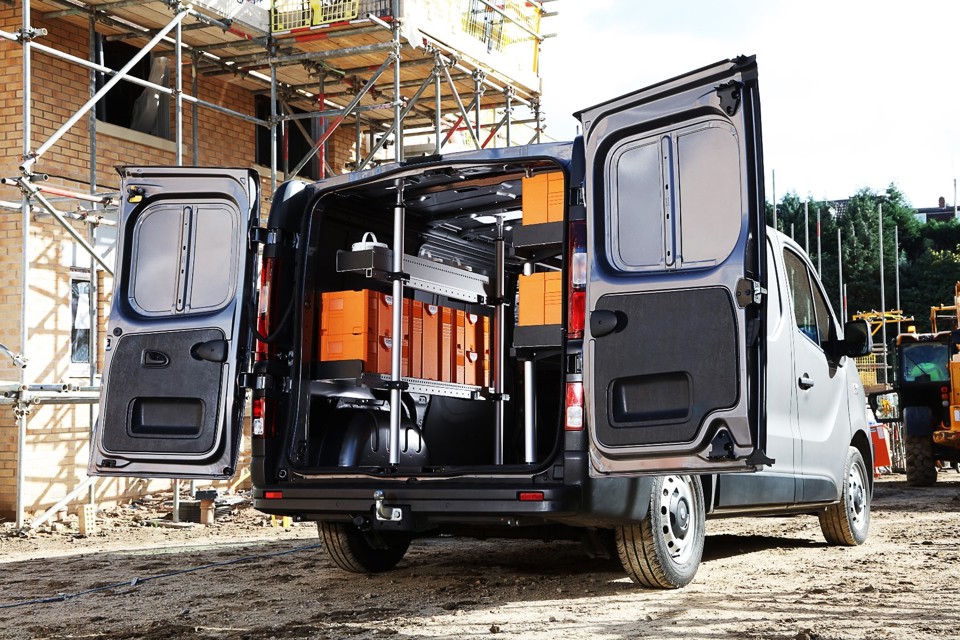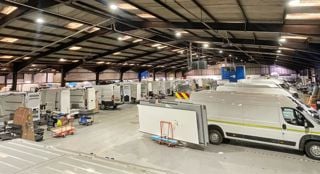A well thought out racking system using lightweight – yet sturdy – materials can increase usable space, improve safety, speed up job completion and save on fuel. It’s an attractive combination.
In many cases, racking is what make a van a usable business tool. Without a racking solution, it is almost impossible to utilise the space in the back of a van correctly or safely.
With cost reduction and safety among the key factors that any fleet operator strives for, racking can play a major part in the type of vehicle you use, the amount of fuel you use and the amount of time your driver has to complete a job.
Fleets are under pressure to improve productivity while cutting costs, but none of that can come at the expense of safety.
Whether it be parcels, tools, spare parts or other equipment, proper stowage will ensure that items can be secure in transit and easy to find when needed.
A loose load can damage both a van and its cargo. A can of paint rolling around in the back could leave a costly mess but a power tool could do even more damage, scratching or even denting the interior panels of a vehicle.
For heavier items the safety risk is even higher. Heavy items can lead to ‘load shifts’ causing the van to lose traction when cornering and then, for vehicles without a bulkhead, the driver could be on the receiving end of an untethered object.
Increasingly, fleet operators are opting for solutions that are customised to their specific business requirements. These solutions can be optimised to meet stricter safety standards and minimise weight at the same time.
Bespoke racking can save time because staff can quickly find the right tools for a job.
Another benefit is that companies can downsize to smaller vans that are cheaper to run if a skilled converter can design a racking system that maximises storage capacity.

Cartwright Conversions is a relative newcomer to the racking market. Sales manager – commercial vehicles Simon Morley says there is no key re-invention of the wheel in the racking industry.
“Fleets are trying to downsize wherever they can – that creates the challenge that they may need to fit a lot in the vehicle but they want to improve economy, efficiency and running costs.
“As a result of that we are tasked with coming up with solutions that allow them to carry as much as they would in something larger.”
Traditional materials, such as wood, are becoming less popular among racking providers.
Despite its low cost, wood is impractical, heavy, offers limited grip and is liable to splinter. Steel, aluminium and plastic are becoming the materials of choice as they can be easily screwed or clipped together and are much lighter.
“Light weighing is a big factor and a big feature of everything we do,” adds Nick Herbert, Bri-Stor commercial director.
He says the industry is driven by emissions and fuel consumption, with businesses focused on not only social responsibility but a desire to minimise costs, too.
“The lighter the conversion is, the more payload people have in their vehicles to carry stuff, or they can carry the same amount using less fuel – there is a cost benefit.
“If you can fit 20% more in every vehicle then there are vehicles they no longer need,” Herbert says.
The industry has experimented with lots of different racking solutions over the years.
Lightweight materials like aluminium may seem like a no-brainer for businesses looking to save weight, but the most popular material in racking is still steel.
The important factor is the strength-to-weight ratio. If you use something too light it may not be strong enough. By the same token, something extremely robust can be expensive to manufacture and weigh more.
“Some suppliers are having forays into alternative materials,” says Herbert, “but we are not there yet.”
Bri-Stor Systems is the commercial vehicle conversions arm of Bri-Stor Group, which includes Alpha Manufacturing – a specialist sheet metal fabrication firm.
“There are many developments we can make with what we currently do, before we look at other materials,” continues Herbert.

By using high-strength steel – which is four times stronger than mild steel – the company is able to make something half as big that is twice as strong as its mild steel equivalent.
Herbert says: “Aluminium is lighter than steel but to get the same strength, robustness, durability and safety you need a lot more material in terms of weight, compared to the equivalent steel system.”
Competitor benchmarking, carried out by Bri-Stor Systems, found its simple shelving unit was between 20% and 30% lighter than rivals.
“When you do the maths, aluminium is not lighter or cheaper,” says Herbert. He believes alternative metals will come from developments in non-metallic structures, but that is still a long way off for the majority of the industry.
Morley says: “Steel racking seems to be the most widely used product. It’s the perfect combination of cost, durability and weight.
“Super lightweight systems are not cost-effective yet.”
Cartwright Conversions can manufacture its own bespoke racking systems, but a large proportion of its business comes from the supply and fit of other companies’ kit.
The business works in partnership with Sortimo, one of the largest suppliers of fully configurable modular van racking components.
“The big players, their steel products are so light and robust. Their steel does the job at a price most operators are happy to pay,” says Morley.
The availability of off-the-shelf racking solutions is high. By using modular systems, fleet operators gain the flexibility to adjust their racking when needed.
This could be when changing vehicles or if the requirements of a vehicle change during its lifecycle.
Fleet operators can tailor a system to suit the specific needs of their particular business.

Modular systems can incorporate shelves, drawers, cabinets, tool racks and lock boxes. The kits can also include sliding shelves, cable reel holders and work benches.
Sortimo is looking to improve access to its products and services with the introduction of MySortimo (revealed at this month’s IAA Hannover show).
It offers 24/7 availability of Sortimo products, enabling fleets to find the right solutions for the tightest of spaces with a fully individualised, turnkey solution.
System Edstrom is a specialist supplier of modular racking equipment that has been in business for more than 50 years.
James Cosgrove, sales manager at the firm, says that one of the key elements of the company’s service is working with fleets to analyse their needs and requirements.
“We try to understand what they are trying to do and how it will impact the payload and space inside a particular vehicle. In many cases, the cost of operating a van full of tools and parts does not meet the expectations of the business,” he says.
A key trend identified by Cosgrove is a move towards smaller vehicles where the driver takes just the equipment that is needed for that particular job.
“There is a culture change that needs to take place if fleets want to do more with less,” he adds.
For some businesses, the solution is to better manage warehouse or depot locations and ensure the right kit ends up in the right vehicles each day.
The previous trend, explains Cosgrove, was for operators to use the largest possible vehicle and load it with every possible item of kit.
“Vehicles need to be as organised as possible with minimal products and tools on-board,” he adds.
But the concept isn’t always well received, with some fleet managers preferring to do things the way they always have.
“There is never a foolproof answer and we don’t want to upset the workforce. But it is always refreshing to have a conversation with a fleet manager about introducing a new idea,” says Cosgrove.
Ways to buy racking
There are plenty of suppliers to choose from in the racking market, along with a host of different ways to build relationships with suppliers.
Going it alone is one option. As many commercial vehicle fleets are used as mobile toolboxes, some are likely to have skilled workforces who can build their own racking systems.
This can prove costly and unproductive, especially for larger fleets, but for those that don’t mind getting hands-on, a number of suppliers will sell flat-packed racking solutions.
There are health and safety and warranty considerations when taking this route but, by far, this would be the cheapest way to rack out a vehicle, with basic kits starting from £100.
Another option is to buy a van with a turnkey conversion, from a dealer or direct from a manufacturer.
These are becoming more commonplace in the van market as fleets demand a more efficient handover and finance process.
One order/one invoice is the ideal scenario and manufacturers are gradually getting on board and offering in-house conversions supported by the major racking providers.
“There is an increase in operators looking for a turnkey solution. Usually it’s small businesses that don’t have the time or money to work with a converter to produce a bespoke solution,” explains Herbert.
“Ultimately they will work around it, rather that it working around them.”
Vauxhall launched an in-house conversions centre at its Luton factory two years ago.
In the same year, Renault announced its Ready-For-Work scheme and, last year, Toyota launched Trade Plus, both providing racking solutions through their respective dealerships in partnership with Bri-Stor.
The benefit to the operator is they only need to deal with one party and pay one invoice. Vehicles will be converted prior to delivery and include the full manufacturer’s warranty.
Dealers, manufacturers and leasing companies all have relationships with conversion companies and racking suppliers and each can provide racking services through preferred suppliers.
Morley says: “I believe the industry, whether it’s one man band or big fleet, want a one-stop shop. Fleet managers do not have time to deal with all aspects of their purchase, and they just want to speak to one person.”
Some fleet managers like to work with all parties to ensure they get the service level needed to keep their business ticking over.

Alison Owen, fleet manager at NRS Healthcare, says she works with her leasing company, dealer and converter like a team.
The company’s 361 Mercedes-Benz vans are all racked out with product from Tevo. It is fitted by specialist conversion firm and Mercedes-Benz-approved converter CRO Vec, in Purfleet.
By using a network of interlinked firms, Owen says the management of the conversion through to processing it at end of life is simple.
“If we are successful with a new contract we usually only get around 12-14 weeks to go live. There’s no option for the vans not to be ready.
"The supplier keeps running stock of the key bits we use, they also fit the tracker while the dash is stripped out and they do our livery too,” she says.
“So far, we have never missed a deadline. They have all been on site, correctly converted and on time.”
While the firms allow for a seamless process, Owen prefers to be involved at each step.
“I’m very hands on. I want to know what I’ve got in my vehicles, what I’m paying for and how it works,” she adds.
At Centrica, conversions are handled slightly differently. The business operates 12,500 vans which all need racking, tracking and wrapping.
Making use of his relationship with Volkswagen, Steve Winter, head of fleet at Centrica, commissions all his vehicles from the company’s factory in Poland.
The majority of the vehicles are Caddys and Volkswagen has the capacity to convert 30,000 vehicles per year straight from the factory.
“It’s a one-stop shop, delivered to the UK and straight to the engineer. There is no movement to commissioning centres,” Winter says.
Last year, the factory was building 100 vehicles a week for Centrica, but it does small volume work as well.
“It’s a little bit cheaper overall and everything is under warranty. You can tell the difference. They use VW Group parts – like lights and fittings – it has a factory-built feel.
“Because it doesn’t leave the plant, they can leave parts out during production like the bulkhead and trim panels. It saves them dismantling it after it’s built.”
A full conversion takes around 12 hours, adding one day to a normal van delivery.
Electric vehicles
As electric vehicles begin pouring off production lines and businesses start to consider switching to a different type of propulsion, the racking industry has been scratching its head as to how a solution will work.
Herbert says: “As hybrid and electric vehicles come into the LCV arena, the key thing with those is range. In the commercial vehicle world a vehicle is pretty useless if it has poor range.
"The range is directly impacted by the weight the vehicle is carrying. If the racking product is lighter it will add extra miles to the range, gradually we can contribute towards making electric vehicles a reality in the LCV arena.”
But, fitting racking to an electric vehicle isn’t as straightforward as it is in a diesel or petrol model.
“The problem with an EV is the batteries are mounted beneath the floor,” explains Cosgrove.
In a traditional setup, the racking system is bolted through the floor of the vehicle as it provides the safest and most rigid mounting.
System Edstrom is working to develop a solution that uses a second bonded floor to which the racking can be mounted.

Autonomy and last-mile delivery
Mercedes-Benz showcased its Vision van in 2017 which was focused on the last mile. The back of the van was self-contained and a robot passed parcels through a hole in the bulkhead to the driver while a drone delivered other parcels.
“That is entirely feasible,” says Herbert. “It’s basically a mini warehouse in a van. There are already fully autonomous warehouses out there, it’s just making it small enough to fit in the back of a van.”
Bri-Stor is seeing an increase in demand for last-mile delivery solutions and it has developed a modular system with drop-down shelving to handle parcels of various sizes.
“The manufacturers we work with are putting quite a lot of volume against last mile as they see it as a massive growth area. We believe last mile delivery will grow and grow,” Herbert concludes.
The benefits of having a quality tacking system far outweigh the initial outlay. A racking system can be used for the life of three-to-four vans dependent on the application. That could be 12 years.
Once you’ve got over the initial cost, the breakdown of cost on a weekly basis is minimal even over six years, but the benefit of utilising the back of a van in a tidy and safe way, then the time you save on a daily basis far outweighs the initial cost.



















Login to comment
Comments
No comments have been made yet.